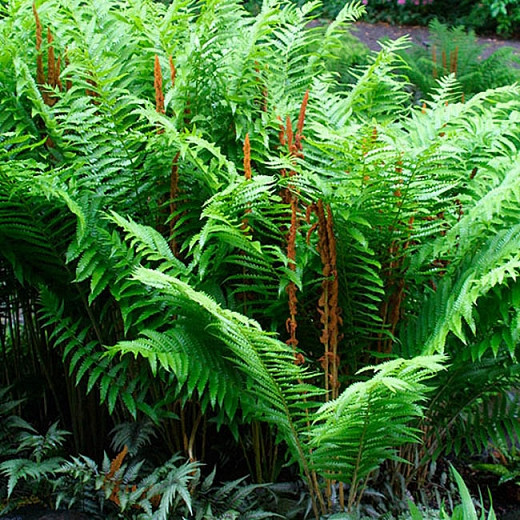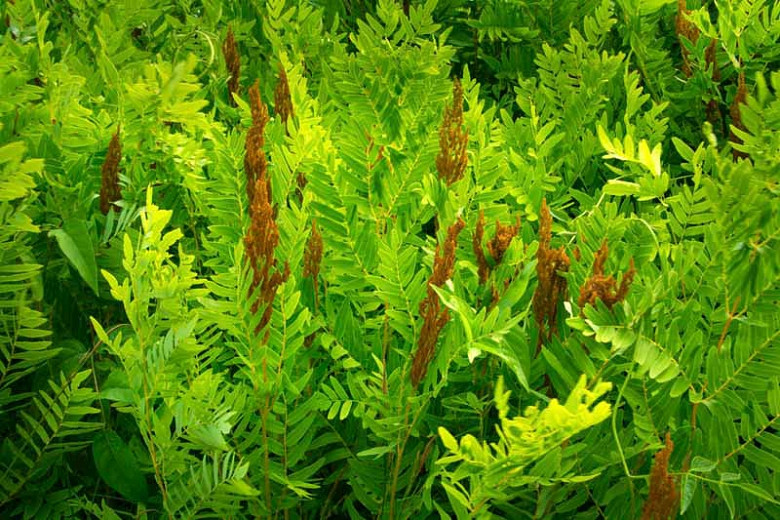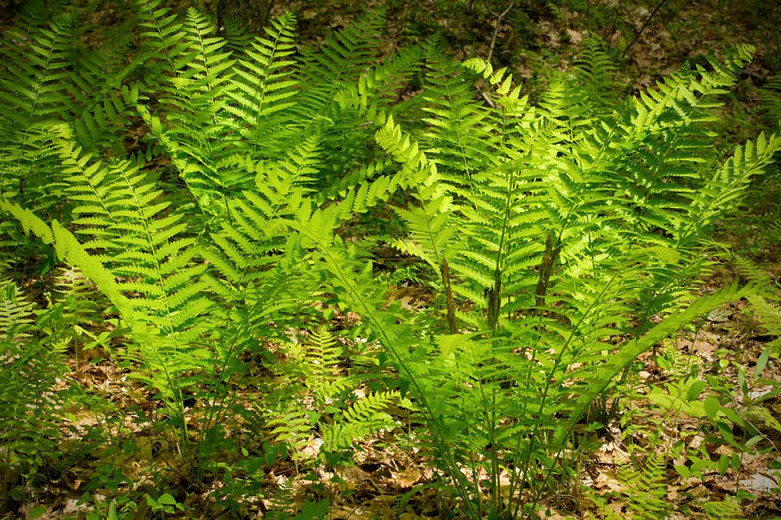Osmunda cinnamomea (Cinnamon Fern)
Thriving in moist areas, Osmunda cinnamomea (Cinnamon Fern) makes a dramatic focal point in the landscape. This impressive, deciduous fern features erect, narrow spikes of cinnamon brown spore-producing structures (sporangia), which emerge from the center of the plant. Resembling cinnamon sticks, these fertile fronds are quite different from the plant's sterile, large, blue-green, lance-shaped fronds and have earned this Osmunda its common name. These fertile fronds appear first as silvery, furry fiddleheads in spring before turning their upper portions to chocolate brown. The sterile fronds bend outwards forming an elegant vase-shaped rosette enclosing the cinnamon fronds. Low maintenance, pest, and disease-free, Cinnamon Fern is a great asset for very wet sites!
- Recipient of the prestigious Award of Garden Merit of the Royal Horticultural Society for its outstanding qualities
- Clump-forming, it easily grows up to 2-5 ft. tall (60-120 cm) and 2-3 ft. wide (60-90 cm).
- A light dapple shade lover, it is best grown in fertile, humus-rich, consistently moist, slightly acidic, well-drained soils. Do not allow the soil to dry out. Can grow in full sun if it is in standing water all the time.
- This plant is a great choice for shady beds, borders, underplanting of roses and shrubs, cottage gardens, woodlands, bog gardens, rain gardens, or along streams, ponds, or water gardens.
- Rabbit, deer, clay & wet soil tolerant!
- Dead or damaged fronds may be removed as necessary.
- Propagate by sowing spores at 15-16°C (59-61°F). These need to be sown within three days of ripening as they lose their viability very quickly. Alternatively, divide well-established colonies into clumps in either fall or early spring
- Native to the Americas and eastern Asia.
Requirements
| Hardiness | 4 – 10 |
|---|---|
| Heat Zones | 1 – 8 |
| Climate Zones | 1, 2, 3, 4, 5, 6 |
| Plant Type | Ferns |
| Plant Family | Osmunda – Ferns |
| Exposure | Partial Sun |
| Season of Interest | Spring (Mid,Late)Summer (Early,Mid,Late)Fall |
| Height | 2' – 5' (60cm – 150cm) |
| Spread | 2' – 3' (60cm – 90cm) |
| Spacing | 36″ (90cm) |
| Water Needs | Average, High |
| Maintenance | Low |
| Soil Type | Clay, Loam, Sand |
| Soil pH | Acid |
| Soil Drainage | Moist but Well-Drained, Poorly Drained |
| Characteristics | Plant of Merit, Showy |
| Native Plants | United States, Midwest, Illinois, Indiana, Iowa, Michigan, Minnesota, Missouri, Ohio, Wisconsin, Northeast, Connecticut, Delaware, Maine, Massachusetts, Maryland, New Hampshire, New Jersey, New York, Pennsylvania, Rhode Island, Vermont, Southeast, Alabama, Arkansas, Florida, Georgia, Kentucky, Louisiana, Mississippi, North Carolina, South Carolina, Tennessee, Virginia, West Virginia, Southwest, Oklahoma, Texas |
| Tolerance | Clay Soil, Deer, Rabbit, Wet Soil |
| Garden Uses | Beds and Borders, Bog Gardens, Ponds and Streams, Rain Gardens, Underplanting Roses and Shrubs |
| Garden Styles | City and Courtyard, Informal and Cottage, Prairie and Meadow, Traditional Garden |



